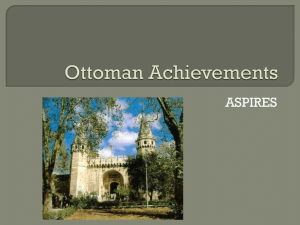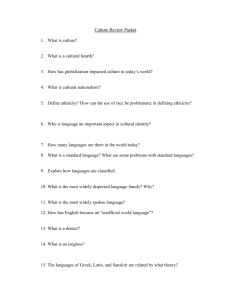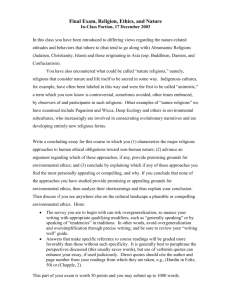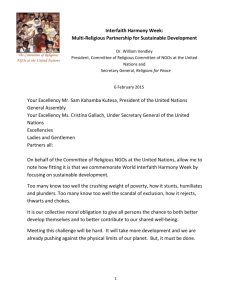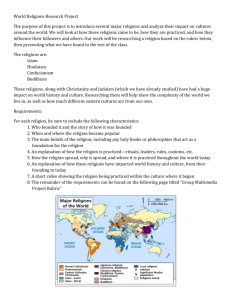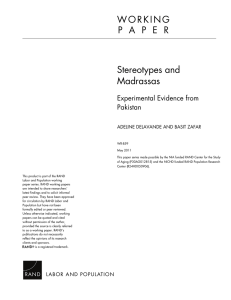Religion and Schooling in Open Society
advertisement
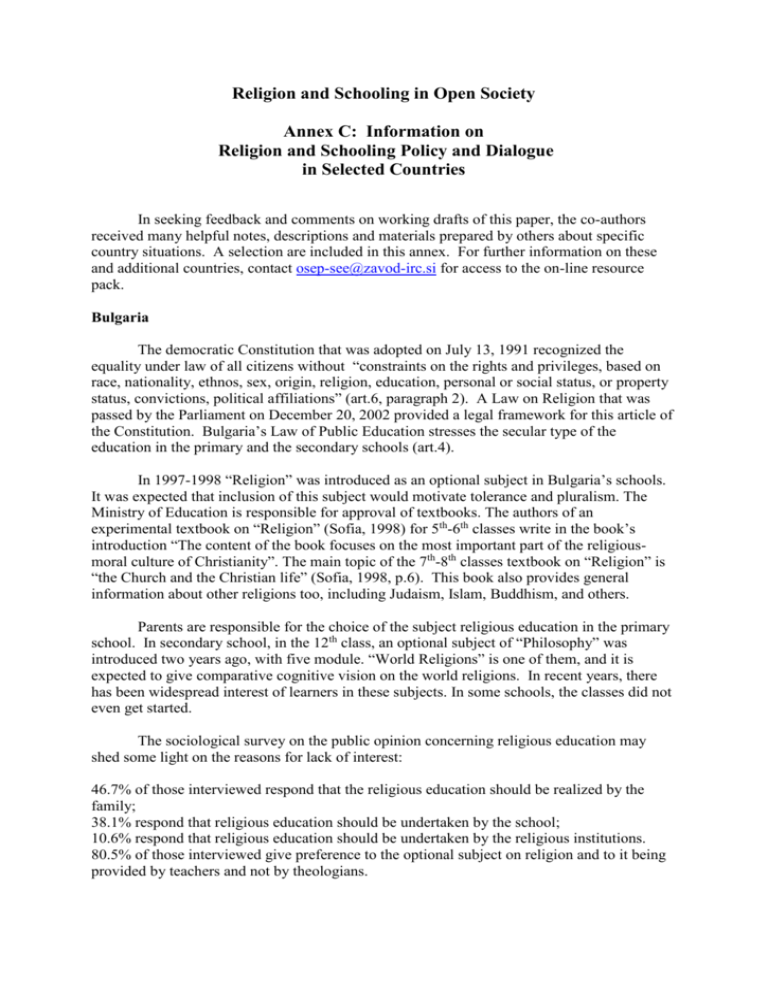
Religion and Schooling in Open Society Annex C: Information on Religion and Schooling Policy and Dialogue in Selected Countries In seeking feedback and comments on working drafts of this paper, the co-authors received many helpful notes, descriptions and materials prepared by others about specific country situations. A selection are included in this annex. For further information on these and additional countries, contact osep-see@zavod-irc.si for access to the on-line resource pack. Bulgaria The democratic Constitution that was adopted on July 13, 1991 recognized the equality under law of all citizens without “constraints on the rights and privileges, based on race, nationality, ethnos, sex, origin, religion, education, personal or social status, or property status, convictions, political affiliations” (art.6, paragraph 2). A Law on Religion that was passed by the Parliament on December 20, 2002 provided a legal framework for this article of the Constitution. Bulgaria’s Law of Public Education stresses the secular type of the education in the primary and the secondary schools (art.4). In 1997-1998 “Religion” was introduced as an optional subject in Bulgaria’s schools. It was expected that inclusion of this subject would motivate tolerance and pluralism. The Ministry of Education is responsible for approval of textbooks. The authors of an experimental textbook on “Religion” (Sofia, 1998) for 5th-6th classes write in the book’s introduction “The content of the book focuses on the most important part of the religiousmoral culture of Christianity”. The main topic of the 7th-8th classes textbook on “Religion” is “the Church and the Christian life” (Sofia, 1998, p.6). This book also provides general information about other religions too, including Judaism, Islam, Buddhism, and others. Parents are responsible for the choice of the subject religious education in the primary school. In secondary school, in the 12th class, an optional subject of “Philosophy” was introduced two years ago, with five module. “World Religions” is one of them, and it is expected to give comparative cognitive vision on the world religions. In recent years, there has been widespread interest of learners in these subjects. In some schools, the classes did not even get started. The sociological survey on the public opinion concerning religious education may shed some light on the reasons for lack of interest: 46.7% of those interviewed respond that the religious education should be realized by the family; 38.1% respond that religious education should be undertaken by the school; 10.6% respond that religious education should be undertaken by the religious institutions. 80.5% of those interviewed give preference to the optional subject on religion and to it being provided by teachers and not by theologians. The subject “Religion” in school should: Provide knowledge on religion as culture – 46.5%; Form spiritual values – 17.4%; Form moral values – 15.5% The survey was published by Sociological Agency ACCA “M” in March, 1996. For more detailed description, see Todorova, Nonka Bogomilova, “Religion – Spirit and Institution”, Academic Publishing House, Sofia, 1999. Prepared by Nonka Bogomila Todorova, Associate Professor of Philosophical Anthropology at the Institute for Philosophical Research and an Open Society International Policy Fellow, Bulgaria Kosova In 2004, a survey entitled “Should religion be taught in Kosovar public schools?” was conducted by a group of students of the Sociology Department, University of Prishtina, under the supervision of Prof. Ismail Hasani. The aim of the survey was to evaluate professionally the opinion of secondary school students on the issue of introduction of the subject of religion within the Kosovar education system. It was intended that the survey would enable the students to formulate some concrete recommendations on the matter.. The survey was carried out in response to the proposal made at the Kosovar Parliament to introduce religious education in schools. After the proposal was made, a petition was signed by approximately 100,000 Kosovars in support of the proposal. The survey research focused specifically on clarifying opinions on the following questions: Will lessons on religion influence pupils to abandon deviant behavior, such as smoking, drinking alcohol, taking drugs, etc.? Will the religion course contribute to increasing the inter-religious tolerance? How should this course be taught and should it belong to one faith only? The methodology used in this survey was qualitative, including focus groups, individual interviews, examination of written materials and photos. A total of 10 Kosovar high schools participated in the survey, amongst different areas of Kosovo--Prishtina, Gjakova, Ferizaj, Gjilan, Vushtrri, Istog, Viti, Drenas, Podujeva, and Skenderaj. In addition to students, teachers were also interviewed. Interviews were confidential, with no identities attributed to the responses. In principle, most of pupils wish to have more information and knowledge about religion, but their attitudes on how should this be done vary widely. Those who are in favor of having a course on religion in schools respond that they believe it will help them to address their emotional problems and to resist negative phenomena such as alcohol and drugs. One respondent said “…Religion teaches you to respect good values, no matter what your faith is, you become a better person and more tolerant, and this would help the school a lot…”. 2 Those who were opposed to introducing a course on religion in schools respond that they believe this will create the wrong image about Kosova : “ …Internationals will think that we are Bin Laden types… there are other places we can learn about religion… what about my best friend who is Catholic, do I have to break up with him?” (Quotations from a focus group in Prishtina). The prevailing opinion of the pupils is that there should be lectures about all religions, and that the course should concentrate on moral values and not on ritual obligations. It is obvious that the presence of active religious organizations in certain areas of Kosova has influenced young people to be more committed to religion. This was noticed in Prizren, Gjilan, Vushtrria, Podujeva, and, in particular, in Skenderaj. The teaching staff had also various opinions, depending on their age and profession. Social science teachers were mostly against introducing such a class at school, as this would harm the insecure political status of Kosova and would create the wrong image of Kosova as a fundamentalist country. Also, the older generation of teachers seemed more resistant to the idea of having lectures on religion. There seemed to be a general opinion of respondents that students who are religious behave well, are kind and quiet. However, they exclude from this category those who expose with clothes or other manifestations and symbols of their particular faith (such as growing a beard, symbols depicting or promoting religion). Also, most of the students responded that they believe school is not the right place for performing religious rituals, and they are against designating locations for this aim. In the current education law, there is no stipulation one way or another on this issue. The ambiguity provides room for misinterpretation in some cases. Many young people respond that there is very little to do for them in their free time. There are no alternative activities besides school, or even if they exist, they are too expensive. As a consequence, they believe there are more chances to occupy themselves with negative phenomena and to become prey of various organizations belonging to organized crime. They think that lessons on religion would help them to avoid this. However, most of the students who responded believe that concentrating in one religion would be dangerous, as it would ruin the relations within a class, where quite often students belong to different confessional traidtions. The specific recommendations of the researchers following this survey are: To prepare the curriculum of a course on religion, involving education institutions in cooperation with religious institutions. This course should : 1. include information about all religions; 2. start from primary school; 3. include the educational and moral aspects of faith; 4. be obligatory but without final evaluation. To train lecturers for this specific course, in accordance with the curriculum. To make respective legislative changes. 3 Translation and Summary of the research findings prepared by Vjosa Rogova, Higher Education Support Program Coordinator, Kosova Education Center Latvia Religious education in schools in Latvia has been available as an optional subject. According to the data from the Ministry of Education from academic year 1998/99, the number of schools providing this optional subject decreased from 83 to 51, and the numbers of students opting for the subject dropped from 8,416 to 3,319. About 1% if the total number of students in basic education opts for this subject. In the summer of 2003, the Minister of Education decided to introduce two subjects from which students must choos. One is Ethics, and the other is Christian Basics. Parents are obliged to choose one of the subjects for their first graders. As of spring 2004, the standards for the subjects were still under development, although the new subject options are to be available in schools from September 1, 2004. A survey of parents and schools about their attitude towards these changes, and a roundtable discussion organized by the Center for Public Policy PROVIDUS showed that 66% of parents learned about these impending changes and new subjects from the mass media. Most of the parents express a preference for an integrated subject of Social Studies, rather than either Ethics or Christian Basics. The survey shows that if the parents are obliged to choose between Ethics and Christian basics, 67 % of parents would prefer Ethics. Christian basics would be chosen mostly by those parents whose children are already attending Sunday schools at a church. All the parents are concerned that the division of a class based on beliefs might negatively affect the climate in the class. The standard of Social Studies was developed and piloted during the last four years within the framework of the World Bank loan and project for education in Latvia. The Ministry’s current decision neglects the efforts that have been undertaken to develop a quality standard of Social Studies. The Center for Public Policy PROVIDUS has initiated information campaigns and its internet portal www.policy.lv has served as a platform for expressing opinions on these matters. Prepared by Indra Dedze, Senior Researcher, Center for Public Policy Providus, Latvia Pakistan In terms of the emphasis on Islam, Pakistan is sometimes seen as a unique case given that Islam was used as a marker of identity in mobilizing Muslims of India behind the demand for a separate homeland. In 1949, the Constituent Assembly passed the Objectives Resolution which defined the principles of the new state. It provided that Pakistan would be a state: 4 "wherein the principles of democracy, freedom, equality, tolerance and social justice, as enunciated by Islam, shall be fully observed; wherein the Muslims shall be enabled to order their lives in the individual and collective spheres in accordance with the teachings and requirements of Islam as set out in the Holy Quran and Sunna; [and] wherein adequate provision shall be made for the minorities freely to progress and practice their religions and develop their cultures." While the Objectives Resolution initially, provided a preamble to the constitution, it was subsequently rendered a substantive part of the constitution. According to Chapter 2 of the Constitution of Pakistan titled `Principles of Policy’ `The state shall endeavour, as respects the Muslims of Pakistan, : (a) to make the teaching of the Holy Quran and Islamiat compulsory, to encourage and facilitate the learning of Arabic language and to secure correct and exact printing and publishing of the Holy Quran;…’ The education system came to be regarded as key in creating a sense of solidarity on the basis of religion among the ethnically and culturally diverse population of the new state. In the First Educational Conference called by the government in 1947, the federal minister of education underscored the need for an educational system based on Islamic ideology. The Second Five-year plan (1960-65) again emphasized Islamic studies and religious education. Mainstream education in Pakistan remains within the public sector at all levels even though elite institutions are much more likely to be found within the private sector. The curriculum for the large number of public sector institutions, including approximately 125,000 schools, is given final approval by the Curriculum Wing of the Federal Ministry of Education. The textbooks commissioned by the provincially based textbook boards adhere to guidelines laid down by the Curriculum Wing. These guidelines repeatedly emphasize the need to inculcate a narrowly defined set of Islamic values. The emphasis on Islamic studies became much more pronounced after General Zia ul Haq’s coup in 1977. Islamiat had been a compulsory subject from Class I up to Class X but it was now made compulsory up to B.A.(Bachelor of Arts degree equivalent to 14 years of schooling). It is not required at the M.A. level, but when students appear in professional examinations such as MBBS (Bachelor of Medicine Bachelor of surgery) or CSS (competitive examinations for the Federal civil services) they again have to study Islamiat as a separate subject and can qualify only if they pass in this exam as well. Under Zia, from Class VI to Class VIII, it was made compulsory for students of all religions to learn Arabic. The justification was to enable Muslim students to acquire a better comprehension of Quranic teachings. Previously, Arabic had been an optional subject. During the same period, a section of the Islamiat syllabus was separated for Sunnis and Shias at the level of Class IX and X. Separate books were introduced for students of the two sects but a common book was re-introduced in 1999. However, they attempt distinct sections of the examination paper. From Class I to Class VIII the subject of Diniyat (Religious Studies) was taught in government schools. But, in 1997, the subject of Islamiat (Islamic Studies) was introduced. The former subject included space for an introduction of other religions, though in practice this does not appear to have been implemented on any significant scale in the classrooms. For students of persuasions other than Islam, there are few practicable options to studying Islamiat. In Class VIII, there is a `Civics Special Paper for non-Muslims,’ for which students 5 of minority communities may appear. However, schools seldom have any provisions for the teaching of this subject. In 1987, a book on ethics to be used by minority communities’ students was produced by the Sindh Textbook Board and subsequently printed by the Punjab Textbook Board, as well. However, it is not readily available. Most non-Muslims students take up Islamiat as a subject even though it is not compulsory. In schools, children generally have at least three periods of Islamiat a week, sometimes more, of 45 minutes each. The Islamiat curriculum places a premium on inculcating a Muslim identity among Pakistani children notwithstanding that at least some children belong to other religious persuasions. In the subject of Islamiat, concepts such as Jihad are framed in terms of waging war against the infidels rather than in the broader interpretation that would privilege Jihad against poverty, illiteracy or inequity. Further, the approved textbooks for the subjects of Urdu, Pakistan Studies, Civics and other subjects also have significant content that pertains to Islamiat. A related issue is that the Islamiat content is perceived as privileging the beliefs of one sect over that of the other. A recent development was the publication by an Islamabad-based independent institute, (SDPI), of a report called The Subtle Subversion: The State of Curricula and Textbooks in Pakistan. The report focused on the subjects of Urdu, English, Social Studies and Civics and examined curricular guidelines that sought to encourage the teaching and learning of Islam and `Pakistan ideology’ in narrowly defined, exclusivist, terms. The government set up a committee to examine the recommendations of the report aimed at curricular reform but reined in its reform aspirations in the face of widespread opposition from politico-religious groups, Urdu-language media, private TV channels, etc. The thrust of the opposition indicated that significant and influential sections of society appeared to believe that there was little seriously wrong with the curriculum or the textbooks in their present form. For instance, the argument that Pakistan, in fact, had been made for the Muslims was often repeated, implying that there was no real obligation to provide room in the education system for children of minority communities. Jihad was seen as a matter of faith for Muslims, and how could it not be taught? A few voices called for the report to be understood in a broader and contemporary perspective. For others, the report seemed simply a matter of political opportunism. Mainstream political parties, for instance, finding comfort in the discomfiture of the government, apparently felt no need to support the argument in favour of a curriculum that provides for a more enlightened view of Islam, promotes a tolerant outlook toward minorities and neighbours and is otherwise more in line with the requirements of the 21st century. The conservative lobbies were also helped by the fact that there has been considerable talk in the West, particularly on the part of US policymakers, regarding the need to effect madrassa reform. These lobbies were quick to posit the connection between the `Western agenda’ and the government’s apparent readiness to consider changes in the curricula. At the same time, they have argued that the quest for friendly relations with India should not mean any undermining of the ideological content of the education system. The debate on the religious and ideological content of the textbooks is of critical importance. But, it has also been used to put the government on the defensive and drawn attention away from the poor quality of the books, which are lacking in creativity, content, structuring, sequencing, coherence and presentation. The issue of reform of madrassas in Pakistan has become the focus of considerable attention in the aftermath of September 11 and the rise of terrorist acts within Pakistan. In part 6 this is due to the recent role of the madrassas in the rise of the Taliban. Consider institutions such as the Maddrassa Haqqania in Peshawar from where the better part of Afghanistan’s Taliban leadership graduated. Of course, earlier on when the Soviets were in Afghanistan the madrassas were seen in a very different light by the US administration and the government of General Zia ul Haq. Madrassas, though by no means all, were a part of the institutional support structure in the Afghan Jihad against the Soviet Union, financed by the US and Saudi Arabia and mediated by Pakistan. But now that the scenario has changed, efforts are underway to `modernize’ madrassa education on the assumption that this will change the mind-set of the students who are a product of the system. As a first step towards controlling the activities of the madrassas, the government has sought to end the enrollment of foreign students in these institutions. There were roughly 250 madrassas in Pakistan in 1947. Before the advent of Zia-ul Haq and the Soviet invasion of Afghanistan in 1979, there were close to 2,500 madrassas. At present the approximate figure may be closer to 10,000 to 12,000 madrassas. To some extent, their growth was encouraged by the state for its own ends. The dismal state of public sector schools has made them a viable option for many. The government now wants the madrassas to register with the state and thereby make themselves eligible for official assistance. Many madrassas do not receive government funds; some find alternative sources. Having registered, the madrassas would be required to teach subjects such as Science, English, and Mathematics. There is also emphasis on computer studies. There are madrassas that claim to teach some of the required subjects already. Given the ethos of the madrassa and the fact that the management and the faculty already associated with the institution will continue, is it likely that there will be a sea-change in the attitude of the madrassa students anytime soon? The government appears upbeat about its madrassa reform efforts. A recent communique of the Embassy of Pakistan in Washington states that under the provisions of the 2001 Madrassah Education Board ordinance, three model madrassas were established in Karachi, Sukkur and Islamabad in 2003. These madrassas are reportedly following the new curricula. The Islamabad madrassa was designed exclusively for girls. If these madrassas were expected to have some sort of a ripple effect, it has yet to appear. More than a million students are a part of the madrassa system. Often they come from the poorest and most deprived backgrounds. To the extent that these students receive an education, it is free and their boarding and lodging, clothes, textbooks, and other needs are covered. Some madrassas even provide a small stipend. Compare this to what the provincial Punjab government means by `free’ education, for example. In Punjab, there nominal fee for public schooling is no longer required. However, families must still financed the more significant expenses of uniforms, books, and meals. Barring exceptions, there is not that much learning that takes place in these public schools either. That these public school students’ attitudes differ from those of their madrassa counterparts is probable, though the gap of difference is surely narrowing. There is a significant private sector role when it comes to primary and middle –level schooling (up to Class V and Class VIII), and the NGO sector is very active at the level of primary schooling. In terms of attitudes and world-view, there seem to be significant differences between the products of these and government schools. But the constraints imposed by the virtual absence of alternative materials, the need to appear for government- 7 held examinations at critical stages, such as Class V, Class VIII, and Class X, and the induction of teachers who bring a certain perspective to the classroom should also be kept in mind. Prepared by Abbas Rashid, Society for the Advancement of Education, Pakistan Serbia In March 2001, The Board for Education of the Assembly of Serbia demanded that religious education (RE) be introduced in the curriculum as a regular subject. Following talks with the Holy Synod of the Serbian Orthodox Church (SOC), the late Prime Minister Zoran Đinđić held talks with the representatives of six more religious communities, on July 5th, and announced the introduction of religious teachings into state schools in Serbia as of September 2001. By government decree, these seven religious communities were proclaimed traditional, thus obtaining the right to religious education in state schools, financed by the state.1 A state commission for RE was set up, consisting of representatives of the religious communities that had been made official as traditional communities and representatives of the ministry of Education and Religions, who were authorized to conceive, apply and supervise RE. The Ministry of Education was given the task of preparing an alternative subject, which, at that time, had neither a name nor a clearly defined role and content. Shortly thereafter, a group of experts conceived an alternative subject to RE, entitled Civic education (CE). The selection of only seven religious communities authorized to implement religious education in state schools sets a precedent, because the previous law did not discriminate between different religious communities. Small religious communities were particularly affected by this exclusion at the time when a fierce public campaign was under way against their practices, which resulted in numerous physical attacks aimed at their facilities and representatives. Moreover, one traditional church, The Romanian Orthodox Church (RPC), which practices officially in the area of Banat, was not included in the seven recognized religious communities. The introduction of RE was accompanied by a fierce public debate regarding the justifiability and character of religious education. The SPC was the chief proponent of the initiative to introduce RE. The demand for its confessional character was explained by the attitude that there is no such thing as a general concept, let alone a universal religion and that a religious experience exists exclusively within a specific religion and a specific denomination. The right to RE was derived from and based on the right to education, the right to choose one’s perspective of the world, the right to religious practice and the parents’ rights to bring up their children in accordance with their religious beliefs. All these rights are provided for by international conventions and make the foundation for RE in other European countries albeit with a variety of models used which was completely disregarded in the debate in Serbia. Other arguments in favor of RE included the omnipresent and increasing crime rate, domestic violence and the alleged appearance and spreading of so-called destructive sects. As in other ex-socialist countries, the dominant argument on behalf of RE was its undemocratic abolition by the communist authorities after WW2. 1 By decree on organizing and implementing religious education, published in the Official Gazette n. 46 of 27 07 2001, the following religious communities were proclaimed traditional: The Serbian Orthodox Church, the Islamic community, The Catholic Church, The Slovak Evangelical Church of Augsburg Confession, the Jewish community, The Reformed Christian Church and the Evangelical Christian Church of Augsburg Confession. These are the denominations that enjoyed the right to religious education in the Kingdom of Yugoslavia, before World War Two. 8 Numerous non-governmental organizations and educational experts warned that the RE was being introduced into state schools against the Constitution and the adopted procedures and standards concerning the introduction of new subjects into the curriculum, which require a two-year experimental application, followed by an expert analysis. Opponents of RE pointed to the fact that, in the Balkans, religions have been a disuniting factor and that the division into confessional RE programs means supporting isolation, reinforcing ethnic divisions and creating obstacles to social cohesion. Some critics pointed out that the introduction of RE indicated a deliberate attempt to avoid tackling the existing problems in education and even the Minister of Education pledged for postponing the introduction of RE in order to prepare competent teaching staff and appropriate materials. Among numerous research polls undertaken to confirm one or the other stand, the research of the Center for study of alternatives in Belgrade stands out. It revealed that the citizens’ opinions on religious education were mixed and inconsistent and that, with considerable generalization, the conclusion could be drawn that one-third of citizens were in favor of the introduction of religious education, one-third were against it and the remaining third were either undecided or uninformed. Several legal acts were adopted since to modify the existing Law on Elementary and Secondary Schools and define the practical implementation of RE. The syllabus for RE, which contains the objectives, tasks and contents of religious education and the manner of implementation of the program, i.e. a brief set of instructions were entirely designed by the religious communities, without the participation of experts of pedagogic orientation or of experienced teachers, who in turn pointed to the disregard of didactic and methodical principles, terminological imprecision and inadequacy for the students’ age. Similar criticism was directed at RE textbooks. Observation of RE in schools revealed numerous problems such as the absence of its integration in the educational system, lack of teaching materials and aids, insufficient preparedness of teachers, lack of student motivation and discrimination of the members of minority religious communities in exercising their right to RE. Students of high schools or the parents of elementary schools students have to opt between RE and CE and as of recently are expected to make their choice only once. The chosen subject becomes compulsory throughout the schooling. The number of those opting for RE is increasing every year. Although current statistics are not available one might safely assume that it is a majority option. The highest popularity of RE is among Muslims in southwestern Serbia followed by Catholics in northern and Orthodox in some regions of central Serbia. Prepared by Bojan Aleksov, OSI International Policy Fellow, Serbia Slovenia In Slovenia, roughly speaking, the situation is very similar to that in France and in the USA2. According to the Slovene Constitution, the Church and State are strictly separated. For this reason confessional religious instruction in public schools is explicitly prohibited by the 2 France and the USA are countries whose constitution entails complete separation of Church and State. The consequence is that no confessional religious education is allowed in public schools. But this does not mean that the religion as such is removed from the curriculum of public schools, because the teaching about religion is permitted. 9 school laws.3 Before the Second World War, confessional religious instruction was an obligatory school subject in public schools. After the Second World War, religious instruction was tolerated in public schools until 1952. From then on, confessional religious instruction was expelled from public schools, and it was organized by the Churches in the ecclesiastical buildings. Only exceptionally was it organized inside the school buildings, but always strictly separated from regular classes. In public schools, religious instruction was replaced by the so-called “civic and moral education”. Slovenia became an independent and sovereign state in 1991. During the first few years of its existence, an important educational reform was being prepared in order to establish an educational system that would be comparable to those in the European Union and other highly developed countries. One of the major changes that happened at that time in primary schools was the introduction of optional school subjects. Each school must now offer at least six optional subjects in the seventh, eighth and ninth year of schooling. Each pupil must choose two from the six optional subjects. Among other possibilities, the pupil may choose a nonconfessional form of teaching about religions, called “religions and ethics”. The contents of this optional or elective school subject are divided into three parts. In addition to the obligatory topics, there are optional topics from which the teachers and the pupils can choose. The principal religious topics are the following: In the seventh year of schooling: obligatory topics are: World religions, Christianity, Islam, and Buddhism. optional topics are: Judaism, Hinduism, Taoism, Confucianism, new religious movements and traditional religions. In the eighth year of schooling: obligatory topics are: religious culture, rites, symbols and the religious communities, religions and the problem of evil, sin, death, ethical dimensions of religions. optional topics are: Churches, sects and monastic communities, relations between Church and State, magic and occultism. In the ninth year of schooling: obligatory topics are: Christianity and Western civilization, the Bible (Old and New Testaments), Catholicism, Orthodoxy, Protestantism, Enlightenment, Christianity in Slovenia, religions and the sense of life, religious freedom and freedom of conscience. optional topics are: religious tolerance, wars of religion, science and religious belief, atheism and humanism. The contents of these school subjects was prepared by a team of experts, including theologists. Until now the contents of this school subject have not been the object of criticism. The object of mistrust and quarrel has been the introduction of “Religions and Ethics” as a 3 The religious instruction is allowed only exceptionally (under certain conditions) in public schools during non-instructional time. In private schools, which are also conceived as institutions that should meet the specific requirements of those parents who want to educate their children in accordance with specific religious, moral and philosophical convictions, the religious instruction is, of course, permitted. 10 specific discipline to public schools. For those who do not agree with the introduction of this new subject, it is only a “masked or hidden religious instruction”, a Trojan horse that allows the return of the Church to the public school. For the Catholic Church, the teaching of this subject “Religions and Ethics” is unacceptable because it is nonconfessional. In other words, it is unacceptable because it is the teaching about religions and not the teaching of a particular religion, and especially, because everything concerning this subject (the training of the teachers, preparation of the educational programs and textbooks and the follow-up) is in the competence of the official institutions of the State, as is the case in all other school matters, and not in the competence of the Catholic Church itself, as it wants. In conclusion, we can say that in Slovenia, there are two forms of teaching about religions at public school: firstly, as a specific subject, optional and nonconfessional, secondly, as a part of some other subjects, in particular, civic and moral education, history and literature. But the Catholic Church in Slovenia is not satisfied with this. It wants to achieve two totally different aims. The first aim, which it wants to achieve immediately, is that the Catholic religious instruction, which children attend in the church, would be recognized by the State as one of the optional subjects in public schools. The second aim is a long-term aim: to establish such a model of religious education in public schools as exists in Austria and in some other, predominantly Catholic, countries in Europe. But these aims are not in conformity with the Slovene Constitution. Therefore, they could be achieved only if the Constitution were changed. Prepared by Zdenko Kodelja, Head of the Center for Philosophy of Education, Education research Institute, Slovenia Turkey Turkey’s 1982 Constitution states that "religious and moral education and teaching is subject to the State's supervision and monitoring. Religious Culture and Moral Education will be a compulsory lesson in primary and secondary schools. Religious education and teaching outside of this scope will be subject to the individual's own choice and the demand of young persons legal guardians..." The 1739 Law on Basic Education (enacted in 1973) states "Secularism is the principle of Turkish national education. Religious Culture and Moral Education is compulsory in primary and secondary schools..." "Religious Culture and Moral Education" is a compulsory lesson for two hours a week between grades 4-8 and 1 hour between 9-11. In grades 4-8 the curriculum focuses on Islamic principles and practice as well as moral teaching, citizenship, national unity, customs etc. We could say that this compulsory lesson does include a significant degree of Islamic instruction (Students are taught the pillars of Islam, namaz and prayers, although some teachers report that they leave it up to the student and their parents whether they learn Islamic prayers. This could be quite different across the country). 11 There are a number of minority schools in Turkey and especially in Istanbul. These are Greek (Rum) and Armenian schools which are also subject to the national curriculum but the Religious Culture and Moral Education lessons are taught by their own religious community. It is only in grades 9-11 that the curriculum begins to include teaching on other religions, and that does not really constitute a large part. Before 2000, teachers of this lesson were (where available) graduates of Faculties of Theology. The previous government placed restrictions on the assignment of these graduates as teachers within the Ministry of Education and now prefers graduates of Religious Culture and Moral Education Teacher Training Departments within these faculties. If teachers who are graduates of these departments are not available, then "form teachers" may give these classes. The curriculum is prepared by the Board of Education in consultation with the General Directorate on Religious Education Religious Affairs and academics of theology departments. The compulsory textbooks are prepared by the Religious Education General Directorate of the Ministry of Education. In Turkey, the debate on religion and education in recent years has centered on imam hatips which are vocational high schools, originally created to train imams. Since the 1970s, a large number of imam hatips have been opened, and their graduates far exceed the demand for practising imams in the country. They have become an alternative source of education for parents who wish to send their children to schools which they believe to provide better religious education and higher moral teaching, especially for their daughters. All vocational high schools in Turkey have different accession procedures to higher education. The current debate moment is that the government wishes to eliminate the "disadvantage" to vocational high schools and enable their graduates wider access to different departments of higher education institutions (at the moment it is largely restricted to the schools in the same subjects) which will then open up the way for them to enter public service. TESEV, a local policy institute, is conducting a study on imam hatips. The intention of the study is to break down myths and open it up the topic to a wider debate. The Education Reform Initiative will try to complement this with alternatives to religious education so that there is a more comprehensive policy on religious education. In Turkey, the training of imams, religious education and the option of schools with stronger religious teaching (at the moment "imam hatips") or parents’ demands are all elements of the debate. Prepared by Ayla Goksel, Education Reform Initiative, Istanbul, Turkey Compiled in July 2004 12


